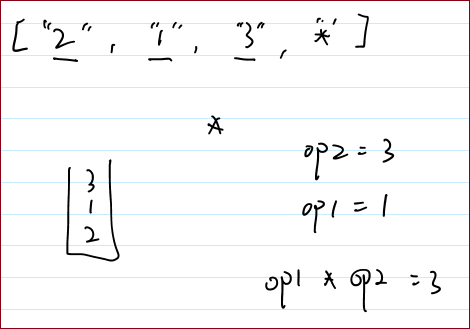[Coding044] LeetCode 150
Evaluate Reverse Polish Notation
Get the knowledge flowing and circulating! :)
目录
※ 本题收获
逆波兰表达式
switch用法复习
String变Integer
字符串判等
题目:150. Evaluate Reverse Polish Notation
You are given an array of strings tokens that represents an arithmetic expression in a Reverse Polish Notation.
Evaluate the expression. Return an integer that represents the value of the expression.
Note that:
The valid operators are
'+','-','*', and'/'.Each operand may be an integer or another expression.
The division between two integers always truncates toward zero.
There will not be any division by zero.
The input represents a valid arithmetic expression in a reverse polish notation.
The answer and all the intermediate calculations can be represented in a 32-bit integer.
Example 1:
xxxxxxxxxx31Input: tokens = ["2","1","+","3","*"]2Output: 93Explanation: ((2 + 1) * 3) = 9
Example 2:
xxxxxxxxxx31Input: tokens = ["4","13","5","/","+"]2Output: 63Explanation: (4 + (13 / 5)) = 6
Example 3:
xxxxxxxxxx91Input: tokens = ["10","6","9","3","+","-11","*","/","*","17","+","5","+"]2Output: 223Explanation: ((10 * (6 / ((9 + 3) * -11))) + 17) + 54= ((10 * (6 / (12 * -11))) + 17) + 55= ((10 * (6 / -132)) + 17) + 56= ((10 * 0) + 17) + 57= (0 + 17) + 58= 17 + 59= 22
Constraints:
1 <= tokens.length <= 104tokens[i]is either an operator:"+","-","*", or"/", or an integer in the range[-200, 200].
代码1(配 · 手绘过程图)
xxxxxxxxxx501class Solution {2 public int evalRPN(String[] tokens) {3 Stack<Integer> stack = new Stack();4
5 int op1 = 0;6 int op2 = 0;7
8 for (String each : tokens)9 {10 switch(each)11 {12 case "+":13 {14 op2 = stack.pop();15 op1 = stack.pop();16 stack.push(op1 + op2);17 }18 break;19 case "-":20 {21 op2 = stack.pop();22 op1 = stack.pop();23 stack.push(op1 - op2);24 }25 break;26 case "*":27 {28 op2 = stack.pop();29 op1 = stack.pop();30 stack.push(op1 * op2);31 }32 break;33 case "/":34 {35 op2 = stack.pop();36 op1 = stack.pop();37 stack.push(op1 / op2);38 }39 break;40 default:41 {42 stack.push(Integer.parseInt(each));43 } 44
45 }46 }47
48 return stack.pop();49 }50}
代码解读 | 评价
思路清晰之后,写出来的代码就比较可观了!
op1 - op2
op1 / op2注意顺序:栈中弹出的第一数是
op2, 第2个数是op1。这个对于加法、乘法没有影响,但是对于减法和除法有影响。
代码2(以前写的代码)
xxxxxxxxxx531class Solution {2 public int evalRPN(String[] tokens) {3 // 定义一个整数栈(Integer)4 Stack<Integer> st = new Stack<>();5 6 // 问题1: 怎样把字符串“12”变成int型呢?7 // 解答:8 // ① Integer.valueOf(string)9 // ② Integer.parseInt(string)10 11 int a = Integer.valueOf(tokens[0]);12 System.out.println(a + 1);13 14 // 问题2:怎样对比两个字符串呢?15 // 解答:str1.equals(".") or !str1.equals(".")16 17 System.out.println(tokens[2].equals("+"));18 19 // coding here20 for (String s : tokens)21 {22 if (!s.equals("+") && !s.equals("-") && !s.equals("*") && !s.equals("/"))23 {24 st.push(Integer.parseInt(s));25 }26 else27 {28 int num2 = st.pop();29 int num1 = st.pop();30 int res = 0;31 switch(s)32 {33 case "+":34 res = num1 + num2;35 break;36 case "-":37 res = num1 - num2;38 break;39 case "*":40 res = num1 * num2;41 break;42 case "/":43 res = num1 / num2;44 break;45 }46 st.push(res);47 }48 }49 50 return st.pop();51 }52}53
代码解读 | 评价
以前写的代码似乎看上去有点复杂呢~
★ 知识点积累 (Java)
// 问题1: 怎样把字符串“12”变成int型呢?
xxxxxxxxxx31// 解答:2Integer.valueOf(string)3Integer.parseInt(string)// // 问题2:怎样对比两个字符串呢?
xxxxxxxxxx31// 解答:2str1.equals(".") 3!str1.equals(".")